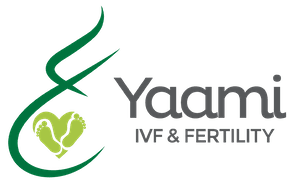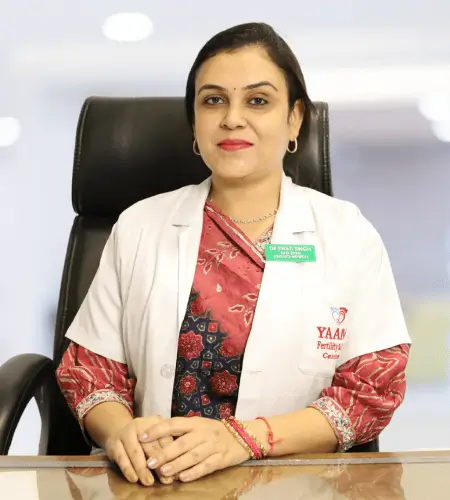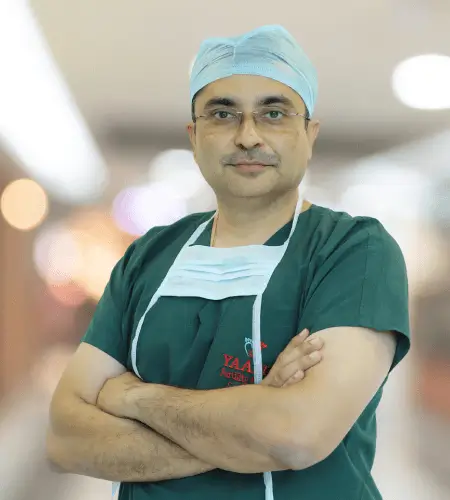
A natural & healthy pregnancy is initiated when a chromosomally normal egg (oocyte) is ovulated from ovary during fertile period, enters open (patent) fallopian tube, gets fertilised with a healthy sperm.
The resulting embryo then enters uterine cavity at blastocyst stage & implants in a receptive lining of uterus (endometrium) during the implantation window.
At Yaami Fertility and IVF Center in Indore, We Firstly do the Couple Fertility Evaluation to see the Chances of Getting Pregnant Naturally.

What is Fertile Period?
- After release from ovary the egg remains suitable for fertilization for approximately 18 hours.
- While a healthy sperm may retain potential to fertilize oocyte for nearly 2 to 6 days from the day of ejaculation.
- Pregnancy is most likely to happen if sexual intercourse happens every 1-2 day, starting from 6 days before ovulation till the day of ovulation
- This time window between day 8-18 of period is considered fertile period.
- A fertile couple has best chance of pregnancy in first 3 month of trial which is in range of 20-37 %.
- Approximately 80 % couple conceive by the end of 1st year of trial for pregnancy.
- By the end of 2nd year, nearly 90 % couple conceive.
- Woman over 35 years & men over 50 years of age have lower chance of conception due to decrease in egg & sperm quality.
It’s recommended to seek evaluation of fertility if you are suspecting any of the following –
In Vitro Fertilization, or IVF is a kind of fertilization where the eggs combine with sperm for fertilization outside the body. This IVF procedure takes place in glass (in vitro). The process involves removing an ovum (egg or eggs) from the ovaries and letting the sperm fertilize them in a liquid.
This process involves stimulating and monitoring in a laboratory. For the next 2-6 days, the fertilized eggs undergo embryo culture also. Later on, it is implantation that takes place in the same or another woman’s uterus. This process intends to establish a successful pregnancy. IVF is a process appropriate for gestational surrogacy and infertility treatment.
- Women with blocked fallopian tubes – The IVF procedure completely bypasses the fallopian tubes. If you are producing healthy eggs that are being blocked from fertilization (or if you have had your fallopian tubes removed), then you may be a right candidate for IVF.
- Women with an infertility disorder – Polycystic ovarian syndrome (PCOS) is the most common cause of infertility in women. If this is the reason for your problems, then IVF may be the right solution for you. IVF may well serve women with other conditions such as endometriosis.
- Women with irregular ovulation cycles – IVF treatment produces more healthy eggs by inducing ovulation, countering an irregular menstrual cycle.
- Men with factor infertility – If your partner has a low sperm count, irregularly shaped sperm, or another male factor infertility challenge, IVF paired with ICSI can deliver a successful fertilization and conception.
The IVF process includes five key steps:
- Ovarian stimulation
- Egg retrieval
- Sperm collection/retrieval
- Fertilization & embryo development
- Embryo transfer
An IVF cycle normally lasts about a month, very similar to a regular reproductive cycle. Day 1 starts at the first day of menstrual bleeding. Most egg collections occur around the 12-14th day of an IVF cycle. But it may vary individually, from patient to patient, and from cycle to cycle.
On the day of the egg collection, the egg is exposed to sperm (IVF) or a single sperm is injected into the egg (ICSI). The embryo transfer will be performed 3-5 days later. And pregnancy test will be performed two weeks after the egg collection. Some clinics utilize oral contraceptives to control the period to ensure the patients going through treatment right on schedule.
Some males are more likely than others to experience infertility. You might be more likely if:
- You’re overweight or obese.
- You’re age 40 or older.
- You’ve been exposed to radiation.
- You’ve been exposed to environmental toxins including lead, calcium, pesticides or mercury.
- You’re a tobacco, marijuana or alcohol abuser.
- You’re taking some medications including cyproterone, flutamide, spironolactone, bicalutamide, cimetidine or ketoconazole.
- You’re around heat that raises the temperature of your testes. Those who frequently use a sauna, hot tub or wheelchair might experience this.
- You have a history of undescended testicle(s).
- You have a history of varicoceles, which are widened veins in the scrotum.
- You’ve been exposed to testosterone. Some males need injections, implants or topical gel for low testosterone.
Infertility is gender neutral. It affects the male and the female population. 1/3rd of the infertility issues are contributed by the female partner. In the world 50-80 million suffer from infertility. Most common causes of female infertility are as follows.
- Age
- Endometriosis
- Hormonal issues leading to ovulation problems
- Tubal blockage
- Fibroids
- Lifestyle factors: Being overweight, smoking, drinking alcohol, unhealthy diet
- Unexplained infertility
There is no specific number. This is determined by the couple together with the physician.
The success rate depends on a number of factors including reproductive history, maternal age, the cause of infertility, and lifestyle factors. It is also important to understand that pregnancy rates are not the same as live birth rates. In the Yaami Fertility & IVF Center, the live birth rate for each IVF cycle started is approximate:
- 41-43% for women under age 35
- 33-36% for women ages 35 to 37
- 23-27% for women ages 38 to 40
- 13-18% for women ages over 40


